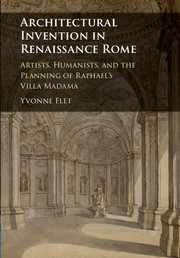 Architectural Invention in Renaissance Rome
Architectural Invention in Renaissance Rome Book contents
- Frontmatter
- Dedication
- Contents
- List of Plates
- List of Figures
- Preface and Acknowledgments
- Note on Translations and Abbreviations
- Introduction: The Nature of Invention, in Word and Image
- 1 Reviving the Corpse
- 2 Writing Architecture
- 3 Sperulo's Vision
- 4 Encomia of the Unbuilt
- 5 Metastructures of Word and Image
- 6 Dynamic Design
- Conclusion: Building With Mortar and Verse
- APPENDIX I Francesco Sperulo, Villa Iulia Medica versibus fabricata/ The Villa Giulia Medicea Constructed in Verse: critical edition and translation by Nicoletta Marcelli and gloss by the Author
- APPENDIX II Francesco Sperulo, Villa Iulia Medica versibus fabricata: Analysis of the presentation manuscript
- APPENDIX III Francesco Sperulo, Ad Leonem X de sua clementia elegia xviiii
- Notes
- Bibliography
- Index
Conclusion: Building With Mortar and Verse
Published online by Cambridge University Press: 06 January 2018
- Frontmatter
- Dedication
- Contents
- List of Plates
- List of Figures
- Preface and Acknowledgments
- Note on Translations and Abbreviations
- Introduction: The Nature of Invention, in Word and Image
- 1 Reviving the Corpse
- 2 Writing Architecture
- 3 Sperulo's Vision
- 4 Encomia of the Unbuilt
- 5 Metastructures of Word and Image
- 6 Dynamic Design
- Conclusion: Building With Mortar and Verse
- APPENDIX I Francesco Sperulo, Villa Iulia Medica versibus fabricata/ The Villa Giulia Medicea Constructed in Verse: critical edition and translation by Nicoletta Marcelli and gloss by the Author
- APPENDIX II Francesco Sperulo, Villa Iulia Medica versibus fabricata: Analysis of the presentation manuscript
- APPENDIX III Francesco Sperulo, Ad Leonem X de sua clementia elegia xviiii
- Notes
- Bibliography
- Index
Summary
THIS NARRATIVE OF THE INTERACTIVE INVENTION OF VERBAL IDEAS, architecture, and decorative forms at Villa Madama opens a window into the inextricably linked visual and verbal culture of early modern papal Rome, and into the working processes of Raphael at the height of his powers as architect and visual culture impresario. Like St. Peter's and the Vatican Palace Stanze, Villa Madama was a laboratory for creating a new system of design and a new visual language – a rhetorical visuality – that would parallel humanist attempts to proclaim the renovatio imperii using neo-Latin. As we have seen, the designs for the Medici villa were produced not only on the architect's drawing board, but also in words: ideas were articulated and elaborated in verse by poets, and in prose by the architect himself. Artists, humanists, and patrons collaborated to produce not simply what art historians call a program or iconography, but complex metastructures of word and image that were embodied in the villa project and its realization. This study has shown how at Villa Madama, the verbal and visual modes of ideation were not parallel, but inextricably connected.
The previous chapters have presented a rare portrait of collaboration, which emerges as a dynamic working method in which concept and design evolved dialectically. On the work table and in social convivia, humanists, artists, and patrons rehearsed their ideas in verse, prose, and plans. This collective design process was performative: a product of a culture of orality and, at times, of improvisation (or at least, claims to such spontaneous creativity – a pretext Castiglione lampooned in his Book of the Courtier). It was also competitive, as artists and wordsmiths vied to promote their ideas. Their notion of the villa evoked ancient prototypes, both literary and extant, from descriptions by Pliny, Statius, and other authors to the ruins of Hadrian's villa complex in Tivoli. The wordsmiths and architects at Villa Madama sought to realize in verbal and visual terms their vision of an all'antica Roman villa; they selected elements of the classical past and brought them together in a new synthesis, thereby creating a new paradigm of the villa for the early modern Medici papacy. In so doing, they enacted a fascinating chapter in the long struggle for primacy of the arts of word and image.
- Type
- Chapter
- Information
- Architectural Invention in Renaissance RomeArtists, Humanists, and the Planning of Raphael's Villa Madama, pp. 170 - 179Publisher: Cambridge University PressPrint publication year: 2018


